Sept. 10, 2016 show
Moravian heritage of Hope, Indiana
Although Columbus, Indiana, in Bartholomew County, south of Indianapolis, is known as a "Modernist Mecca" for midcentury architecture, the small town of Hope in the county's northeast Haw Creek Township has its own unique heritage.
Hope was founded in 1830 by Protestant Moravian Martin Hauser from Salem (now Winston-Salem) North Carolina. The Moravian Church had its origins in 1457 in Moravia, an area now a part of the Czech Republic. Moravians pre-dated the Protestant Reformation with breaks in belief from the Roman Catholic Church and were likewise subject to persecution.
 Like many groups seeking autonomy and religious freedom, Moravians moved into different parts of Europe and on to America, where they settled mostly in North Carolina and Pennsylvania. German was the language spoken by Moravians coming to America. Like many groups seeking autonomy and religious freedom, Moravians moved into different parts of Europe and on to America, where they settled mostly in North Carolina and Pennsylvania. German was the language spoken by Moravians coming to America.
Hope was originally settled as a "congregational town" for Moravians only, with land and property being owned and managed by the church and leased to church members. Simply put, the church owned and ran the town. Somewhat similar to social experiments in New Harmony with communal property, the "congregational town" concept ended in Hope in 1837 when the town was opened up to individual property ownership, and non-Moravians also were allowed to settle there.
Some early residents of Hope were descendants of the settlers of the ill-fated Moravian Mission that operated near Anderson, Indiana, along the White River from 1801 to 1806. The mission's purpose was to bring Christianity to the Native Americans in the area. The mission members and its Native American "converts" were met with strong resistance by local tribes, and in particular by "The Prophet," the brother of Shawnee leader Tecumseh. Learn more about The Prophet's "Indian witch hunts" on the show.
 The Hope Moravian Church, founded in 1830 and originally a log cabin on the town square, remains the only Moravian Church in Indiana. Many of its traditions continue today, such as display of the "putz," or elaborate Christmas scene in miniature, in the church at Christmastime, the tradition of hanging Moravian stars, and the making of Moravian sugar cakes, a type of sweet raised coffee cake widely sold at local festivals. The Hope Moravian Church, founded in 1830 and originally a log cabin on the town square, remains the only Moravian Church in Indiana. Many of its traditions continue today, such as display of the "putz," or elaborate Christmas scene in miniature, in the church at Christmastime, the tradition of hanging Moravian stars, and the making of Moravian sugar cakes, a type of sweet raised coffee cake widely sold at local festivals.
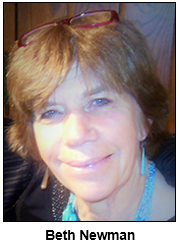 The historic section of the Hope Moravian Church Cemetery is known as "God's Acre," with its first burial in 1833. Members were buried in the "choir" system, where burials are by gender, with a section for boys, unmarried men, married men, girls, unmarried women, married women and paupers. This follows the early Moravian custom of burial as done originally in Herrnhut, Germany. The historic section of the Hope Moravian Church Cemetery is known as "God's Acre," with its first burial in 1833. Members were buried in the "choir" system, where burials are by gender, with a section for boys, unmarried men, married men, girls, unmarried women, married women and paupers. This follows the early Moravian custom of burial as done originally in Herrnhut, Germany.
Since the 1830s, Hope Moravians have also gathered in God's Acre for the Easter Sunrise Service, which includes a trombone choir and a processional by all church members that involves singing songs and watching the sun rise in the east.
This show will be guest-hosted by producer Molly Head, giving Nelson time off to conduct one of his famous tours that delve into Indiana history and notable Indiana people.
Molly's guests include two retired Hope elementary school teachers who also are great storytellers: Barb Johnson and Beth Newman. Both Barb and Beth have taught 4th-grade Indiana history and also have been schoolmarms at the Simmons School, which is a brick one-room schoolhouse that was moved from its original location in the country to the "back yard" of the Hope Elementary School in 1989. And guests Barb and Beth are involved in the Yellow Trail Museum, the history museum located on the town square. Much of downtown Hope and surrounding residential areas is listed on the National Register of Historic Places.
On Sept. 17-18 in nearby Hartsville, Haw Creek Township's Bicentennial Festival will feature music, old-fashioned games for children and tours of Hartsville. The Bicentennial torch is expected to pass through Hartsville at 5 p.m. on the 18th. We also expect a call in to the show from Perry Hammock, executive director of the Indiana Bicentennial Commission. And don't forget to call in with your questions and comments at (317) 788-3314.
Roadtrip: Meet Col. Eli Lilly
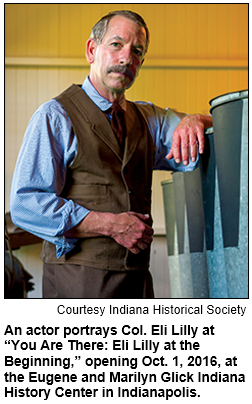 Guest Roadtripper Rachel Hill Ponko of the Indiana Historical Society says she is learning all about Eli Lilly and Company's strong Hoosier ties. Guest Roadtripper Rachel Hill Ponko of the Indiana Historical Society says she is learning all about Eli Lilly and Company's strong Hoosier ties.
"I'm not a native Hoosier," says Rachel. "While there's no denying Eli Lilly and Company is a household name, I didn't realize this successful, multinational corporation got its start just blocks away from where I've lived and worked for the past few years."
Today, a plaque marks the site where Colonel Lilly (the "first" Eli Lilly; his grandson also had the same name) opened his original laboratory on Pearl Street in Indianapolis in 1876. Visitors can use their imagination to envision the small two-story red-brick building in the early days of the city's wholesale district.
On Saturday, Oct. 1, visitors to the Eugene and Marilyn Glick Indiana History Center can take it a step further - quite literally. IHS's new exhibition, You Are There: Eli Lilly at the Beginning, will allow guests to step through an image of the storefront, projected on a fine sheet of mist, to go back in time to the company's second year of operation. Guests will meet actors portraying characters from the company's past, including Eli Lilly and several of his first employees, as they toil in the drug-making business.
"Construction on the exhibit is well under way," says Rachel. "What I'm most excited about, though, is the opportunity to pull back the curtain on the man behind the business. Visitors will learn how Colonel Lilly overcame several challenges in his personal life and career to reach his eventual success."
History Mystery
In addition to Hope's unique Moravian heritage, the town holds the distinction of having a "first" that is related to the U.S. Postal Service.
Question: What is that distinction?
Hint: There is a tiny "museum" dedicated to this distinction on Hope's town square.
The call-in number is (317) 788-3314. Please do not call into the show until you hear Molly pose the question on the air, and please do not try to win the prize if you have won any other prize on WICR during the last two months. You must be willing to give your name and address to our engineer and be willing to be placed on the air.
The prize is a gift certificate to the fish fry at the Hartsville Bicentennial Celebration in Hartsville in Bartholomew County on Sept. 17-18, courtesy of our guests, and a gift certificate to Story Inn in Brown County, courtesy of Story Inn.
Your Hoosier History Live team,
Nelson Price, host and creative director
Molly Head, producer, (317)
927-9101
Richard Sullivan, webmaster and tech director
Pam Fraizer, graphic designer
Garry Chilluffo, media+development director
www.hoosierhistorylive.org

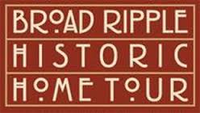 
 
 
 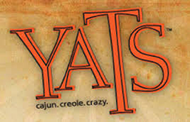
Please tell our sponsors that you appreciate their support: Broad Ripple Historic Home Tour | Cook Medical | Indiana Authors Award | Indiana Historical Society | Lucas Oil | Mr. Tequila's Cantina & Grill | Scott Keller Appraisals | Shirley Brothers Mortuaries & Crematory | Story Inn | Visit Indy | Yats Cajun Creole Restaurant
  Acknowledgments to Monomedia, Visit Indy, WICR-FM, Fraizer Designs, Heritage Photo & Research Services, Derrick Lowhorn and many other individuals and organizations. We are an independently produced program and are self-supporting through organizational sponsorships and individual contributions. We do not receive any government funding. Visit our website to learn how you can support us financially. Also, see our Twitter feed and our Facebook page for regular updates. Acknowledgments to Monomedia, Visit Indy, WICR-FM, Fraizer Designs, Heritage Photo & Research Services, Derrick Lowhorn and many other individuals and organizations. We are an independently produced program and are self-supporting through organizational sponsorships and individual contributions. We do not receive any government funding. Visit our website to learn how you can support us financially. Also, see our Twitter feed and our Facebook page for regular updates.
Sept. 17, 2016 show - encore presentation
Two sensational murders in the 1920s
One murder case involved a bootlegger who killed his wife - and attempted to pin the crime on their chauffeur. The other case involved a woman, called a "feminine Bluebeard" by journalists in the 1920s, who poisoned her husband. Make that two husbands. She probably poisoned one of her fathers-in-law as well.
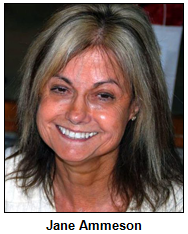 The setting for the first case during the Roaring '20s was urban: East Chicago, which was a boom town in 1923. That's when handsome bootlegger Harry Diamond shot his wife, Nettie Herskovitz Diamond, who had been a wealthy widow when she married him. The setting for the first case during the Roaring '20s was urban: East Chicago, which was a boom town in 1923. That's when handsome bootlegger Harry Diamond shot his wife, Nettie Herskovitz Diamond, who had been a wealthy widow when she married him.
The setting for the other crimes was much more rural: Hancock County. That's where Clara Carl poisoned her husband, Frank Carl, when the couple was living in the small Indiana town of Philadelphia. She probably also poisoned Frank's father, 85-year-old Alonzo Carl, as well as her first husband, Robert Gibson.
In this encore broadcast of a show from our Hoosier History Live archives (its original air date was July 18, 2015), we explore two murder cases that drew national attention to Indiana during the early 1920s. Nelson is joined by two studio guests who have researched the lurid crimes:
- Jane Ammeson, author of A Jazz Age Murder in Northwest Indiana: The Tragic Betrayal of Nettie Diamond (The History Press). Jane grew up in East Chicago near several sites associated with the Diamond family. In fact, Jane's mother once dated the son of Nettie Herskovitz Diamond, whose past remains mysterious.
 It's unclear whether Nettie (who became a pharmacist, a rarity for women during the era) was married three or four times. It's unclear whether Nettie (who became a pharmacist, a rarity for women during the era) was married three or four times.
- Brigette Cook Jones, the Hancock County historian. Brigette began researching the Carla Carl case after inquiries from a cable TV show that broadcast a program about the murders. After the death in 1921 of Frank Carl by arsenic poisoning, the bodies of his father and Robert Gibson were exhumed. Both of them also were found to have shockingly high levels of arsenic in their systems. As a speaker about historic topics, Brigette has been doing presentations about the murders and subsequent trial of Clara Carl.
Both murder cases became "tabloid fodder," to use a phrase from Jane's book. When Nettie Diamond was shot and savagely beaten on Valentine's Day 1923 by her husband in their Hudson sedan, some newspapers described it as "the most famous murder case in the history of Lake County."
With both of the murder cases that we will explore, sensational trials followed the crimes. During the trial of Clara Carl, the Hancock County prosecutor referred to her as "rotten to the core."
Tune in to our show to hear Nelson's guests describe the eventual outcomes of both cases.
Next newsletter for Sept. 24 show
We'll be back!
With the airing of an "encore" show on Sept. 17, your hardworking Hoosier History Live crew will be taking a much-needed break. Our next newsletter will be for the Sept. 24 show.
© 2016 Hoosier History Live! All rights reserved.
|